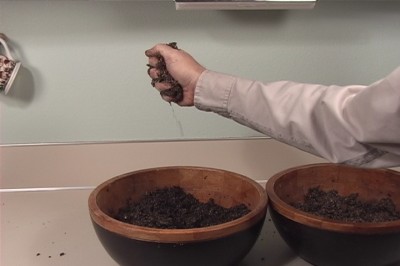|
Terrarium/Fruiting Chamber tek
|
Casing Layer Preparation Here are a few sample clips from the Casing Layer chapter of our Let’s Grow Mushrooms DVD.Depending on the species you’re growing, a well-maintained casing layer can be of great benefit. Some species will not fruit in captivity without a casing layer, while others, such as P cubensis on horse manure, straw or coir, will benefit little. The two main functions of a casing layer are to supply moisture to the substrate below, and to provide a humid area with lots of little air pockets just above the substrate, which stimulate the formation of primordia. The method shown in this video combines peat, vermiculite, gypsum and agricultural hydrated lime, which are then hydrated to what we refer to as field capacity, before being pasteurized at 140F to 160F (60C to 70C) for one hour to kill off mold spores and most bacteria.
A short sample from the casing layer preparation video. Download Let's Grow Mushrooms, Only $8.99
We never want the casing layer to fully colonize. We need to be able to mist it, and have the uncolonized parts absorb and hold moisture, feeding it slowly to the mycelium below. In addition, by keeping the casing layer nice and moist, hyphal knots are encouraged to form in the near saturation humidity at the substrate-casing layer junction. Due to the fact that we have uncolonized organic matter in a high humidity environment, molds, especially Trichoderma, the forest green mold, are real problems we have to plan for and do our best to prevent. We do this by providing the right conditions for mushroom mycelium, while denying molds the environment they crave. Thus, we lime our casing layers to an initial pH of around 8 to 8.5, which helps to prevent mold spores from germinating, while allowing live mushroom mycelium, which is more tolerant of a basic pH to continue to grow. In addition, molds prefer a stale, still-air environment, while mushrooms in the fruiting stage like fresh, moving air. Therefore, in addition to liming our casings to a high pH, we achieve a greater degree of mold control via regular fresh air exchanges in our fruiting chambers or greenhouses. Incidentally, these fresh air exchanges are also a major mushroom pinning trigger, thus we accomplish two tasks with one operation. Enjoy the clips.
_________________________________________
RR Video - 415 N Empire Creek Road - Malo, WA 99150 - USA _____________________________________________________________ Text, Images, and Videos on this website are copyrighted. These video clips may be freely distributed and posted elsewhere for non-commercial purposes, provided they're left in the original form and linked back to www.mushroomvideos.com |

